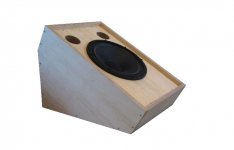Hi everyone ! I'm getting into a dilemma into building a vented or a sealed box for this driver. This is for a DJ booth monitor.
According to the specs ( https://www.beyma.com/speakers/Fichas_Tecnicas/000003719.pdf ), and when entering it in BassBox + WinISD, I should build a vented type for this driver, but a problem arise when I design the vented enclosure (a prism one) : When I look into the Vent Air Velocity in BassBox + WinISD, it tells me that there will be turbulances/noise until 100Hz.
So from my understanding, I should build a bigger vented enclosure in order to be able to fit a large enough vent to fix the problem or go for a sealed type.
At the same time :
- For the vented type : increasing the box volume puts the "cone displacement" graph in the dark zone (bigger risk of killing the driver)
- For the sealed type : there is a 10db difference between the sealed and vented enclosure, which would decrease the music experience for the Dj's from 60Hz to 200Hz
In short, I'm pretty sure I will go for a sealed box, but rather prefer to ask here before starting anything. What would you advice from your experience ?
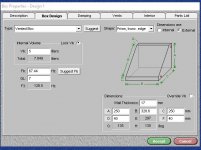
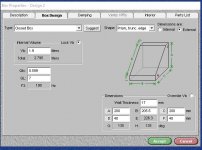
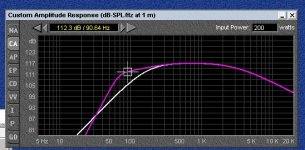
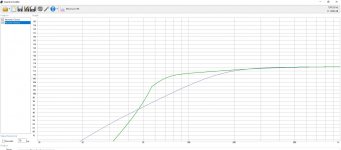

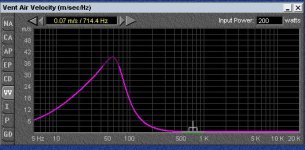
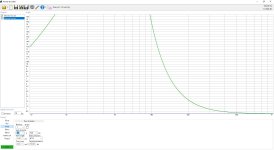
Kindly ^^
According to the specs ( https://www.beyma.com/speakers/Fichas_Tecnicas/000003719.pdf ), and when entering it in BassBox + WinISD, I should build a vented type for this driver, but a problem arise when I design the vented enclosure (a prism one) : When I look into the Vent Air Velocity in BassBox + WinISD, it tells me that there will be turbulances/noise until 100Hz.
So from my understanding, I should build a bigger vented enclosure in order to be able to fit a large enough vent to fix the problem or go for a sealed type.
At the same time :
- For the vented type : increasing the box volume puts the "cone displacement" graph in the dark zone (bigger risk of killing the driver)
- For the sealed type : there is a 10db difference between the sealed and vented enclosure, which would decrease the music experience for the Dj's from 60Hz to 200Hz
In short, I'm pretty sure I will go for a sealed box, but rather prefer to ask here before starting anything. What would you advice from your experience ?







Kindly ^^
Qts seems low for a sealed box. You can add some series resistance and/or use Linkwitz transform. I am assuming an active crossover is being used. If not, added resistance is the only way.
But the fundamental excursion limits of the transducer cannot be avoided regardless of how you choose to use the driver.
But the fundamental excursion limits of the transducer cannot be avoided regardless of how you choose to use the driver.
thx sangram and yes, using an active crossover + this one internally in the enclosure Beyma Crossovers - Beyma FD2CX 2-way crossover - Beyma FD2CX 2-way passive 2.6kHz crossover. The Beyma FD2CX crossover is rated at 500 watts AES. Beyma crossovers here.
Edit : wow I really need a miniDSP regarding the Linkwitz transform. Power in numbers ^^
Edit : wow I really need a miniDSP regarding the Linkwitz transform. Power in numbers ^^
Last edited:
Sealed will reduce the ultimate SPL that speaker will be capable of and Linkwitz transform will make that situation worse.
Rod Elliott tells us that performing a Linkwitz transform reduces the drivers max SPL by 12dB.
ESP - The Linkwitz Transform Circuit
Given the intended application I would stick with ported and make sure the speaker is appropriately high passed for safety.
A passive radiator could be a viable to good compromise here.
Rod Elliott tells us that performing a Linkwitz transform reduces the drivers max SPL by 12dB.
ESP - The Linkwitz Transform Circuit
Given the intended application I would stick with ported and make sure the speaker is appropriately high passed for safety.
A passive radiator could be a viable to good compromise here.
Last edited:
Thx Charles, I'll listen to your advices so. I'm happy to get advices about which volume / FB I should build as a vented box in order to not have port noise and cone extrusion.
in // I'm investigating about a passing radiator design. BLESS
in // I'm investigating about a passing radiator design. BLESS
Last edited:
That driver has a very low Qts and this might give problems with simulators ie they tend to give results with small box volumes and port tuning too high.
Try simulating with internal box volume = Vas and the port tuned to Fs.
Usually that results in an Extended Bass Shelf (EBS) alignment. This means that somewhere below 200Hz the the output drops by about 3dB and stays there down to Fs.
However that is the predicted free air and your usage suggests that the speakers will close to at least one boundary so I don't think the 3dB drop will be a problem and possibly a bonus.
Try simulating with internal box volume = Vas and the port tuned to Fs.
Usually that results in an Extended Bass Shelf (EBS) alignment. This means that somewhere below 200Hz the the output drops by about 3dB and stays there down to Fs.
However that is the predicted free air and your usage suggests that the speakers will close to at least one boundary so I don't think the 3dB drop will be a problem and possibly a bonus.
Okay, listening to your advices is fixing all the apparent problems (vent noise / cone excursion / room to fit the vent in the enclosure).
The only downsize is the larger size of the enclosure as I wanted to do something small. compromises, compromises 😱
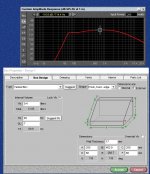
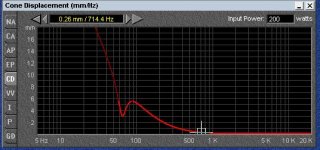

Regarding the port placement, any idea ? As it's a wedge enclosure and since the port should be 200mm width x 20mm height x 287.1 long . I don't have much choice but putting in on one of the side. Slot port would be alright or should I avoid ?
Here are some design I'm inspiring myself from :
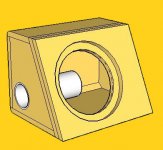
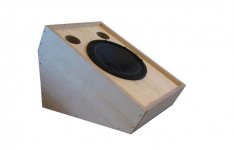
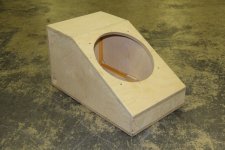
The only downsize is the larger size of the enclosure as I wanted to do something small. compromises, compromises 😱



Regarding the port placement, any idea ? As it's a wedge enclosure and since the port should be 200mm width x 20mm height x 287.1 long . I don't have much choice but putting in on one of the side. Slot port would be alright or should I avoid ?
Here are some design I'm inspiring myself from :



Attachments
Last edited:
- Status
- Not open for further replies.
- Home
- Loudspeakers
- Multi-Way
- Beyma 6CX200Nd coaxial / prism enclosure / sealed or vented ?
